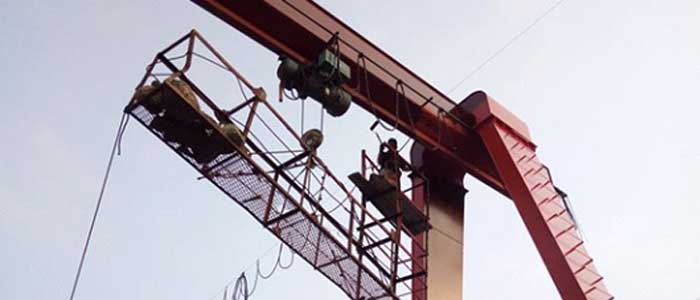
Crane repair and maintenace
Crane repair should be conducted regularly and efficiently to guarantee no signs of wear that may endanger the crane operator or crane related workers. At overhead travelling crane working shop, it is always busy, crowded and short of time, the following checklist is given for your reference to make the detection of the most common signs more efficiently that your overhead crane and hoists needs repair.
Corrosion is one of the problems of overhead crane repair that can creep on you until it demands serious attention. Rust starts small, often goes ignored, and does not appear to affect the performance of the overhead crane and hoist equipment, especially in wetter regions or places with higher moisture.
Corrosion may result in bad consequences, such as electrical shorts, compromised lifting systems, loss of mechanical strength, and overhead cranes or hoist systems that are in danger of dropping their loads due to compromised integrity.
In order to prevent the happening of the above overhead crane accidents, it is vital to detect corrosion which tells you that overhead crane repair is needed or a crane parts need to be replaced.
Crushed chain links are another common problem when working with chain based hoist systems or similar parts or components. If heavy loads are lifting during the project hours, the chain links are easy to get crushed or broken.
To prevent crushed chain crane accidents, it is obliged to make frequent chain inspection and maintenance a regular practice in these situations. Don’t turn a blind eye on the crushed chains which is very different from a completely broken chain links and more difficult to be detected, especially from a distance.
Do repair your overhead crane and hoist when the crushed chain links detected.
A crane hook is designed to hold load weight in a particular and precise direction. A crane hook is a comparatively delicate component, which can be bent by misapplied weight, compromising its internal integrity. The bent crane hook has high possibility of braking off in the future use.
Crane hooks should be inspected regularly to make sure they have not been damaged slightly.
Pads are widely used on lifting cranes and hoists as stabilizer, outrigger and slider pads, which are used to take the brunt of the brunt of the force and make the lifting equipment travel smoother. Naturally, the pads wear out much quicker than other crane parts and components. Inspect the pads for shining and wear which means replacement is needed. Abnormal noisy in the lifting crane or hoist should be noticed for it may be caused by the wearing pads.
Rated load capacity is unknown to all which is not really a physical of needed repairs, but it is a clue that repair work may be needed in your future. Every component you use is rated for a specific load capacity and testing is required. If there are crane parts or components, likely used for handling heavy loads, the rated load capacity of which are unknown, they may put a dangerous stain on keys.
Heat, cold, and constant work play havoc with the more flexible parts of your lifting crane and hoist, particularly the ropes and slings. Ideally, a regular maintenance such as oiling should be conducted according to schedule to preserve them in the right conditions.
Without adequate maintenance, it will result be dry, brittle fiber that stretches and cracks well ahead of its time. If your crane rope or sling fibers are looking ancient and ragged, then repair and replacement may be needed.
Since abrasion happens slowly, it may sneak up on work crews. However, the consequence will be dramatic when a component breaks.
Check your crane wire, joints, and all moving parts for the tell-tale, shiny surfaces that signify abrasion. Keep your eyes on those places.